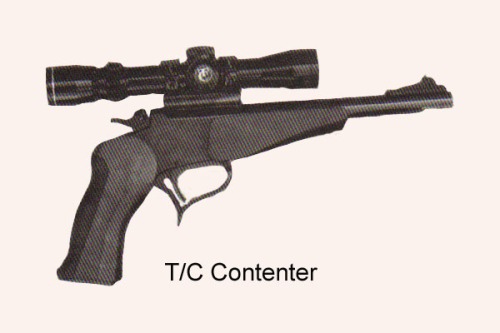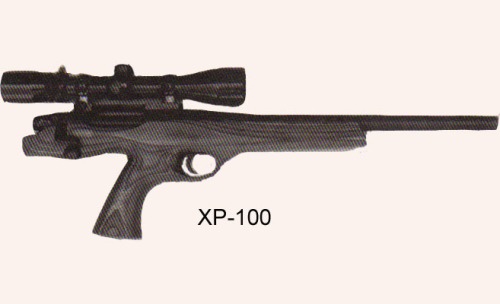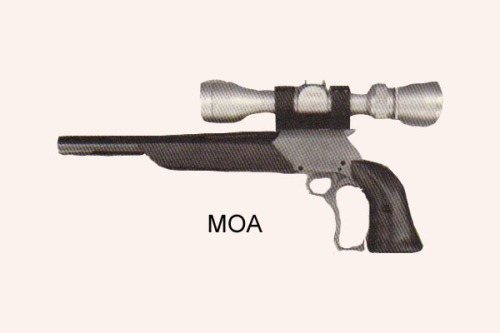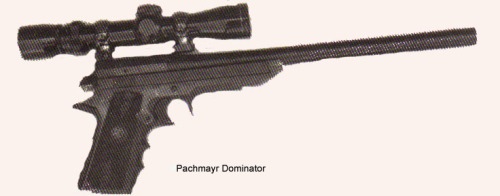 We live in an age of labels. Worse still, most of these labels are assigned with political motives to achieve a calculated emotional effect. Shooters suffer as much or more than any other group from this 20th century phenomenon.
We live in an age of labels. Worse still, most of these labels are assigned with political motives to achieve a calculated emotional effect. Shooters suffer as much or more than any other group from this 20th century phenomenon.
Some of the best known examples include:
If it has a black, plastic stock, it’s an assault weapon.
If it’s a military related development, it’s only possible purpose is to kill people.
If it’s a small, relatively inexpensive handgun, it’s a Saturday Night Special.
Perhaps the most ridiculous example here on the West Coast was our governor’s stated rationale when he signed the bill banning the T/C Contender single-shot with a .45 Colt/.410 pistol barrel in California: “We want to keep these guns out of the hands of the gangs.” Well, you can imagine how much safer I feel!
In my usual, rambling fashion. I have subtly introduced the contents of this article and you, the reader, have grasped the nuances of my title. But just in case my brain is becoming dysfunctional (another popular ’90s label that tends to absolve adults of personal responsibility for their actions), we’re going to look at the currently available single-shot pistols in .223 caliber.
No, they clearly are not assault weapons. But they all fire a round developed for military use (even though we renamed it for the civilian market) and there is black plastic or rubber on some of the guns. What they do represent is possibly the most accurate group of handguns on the planet, and every one of them, in its own way, is a thing of beauty in form or function.
T/C Contender
We’ll begin with the gun that, more than any other started the American handgunner’s current love affair with single-shot pistols. And in return for that love, T/C has made numerous improvements over the years in response to field inputs.My test gun was blued, had a 10 inch barrel, very attractive wood forend and grip with the rubber insert at the back of the grip. Optics consisted of a streamlined set of T/C base and rings and the company’s 2.5-7x variable lighted pistol scope.

The scope has an extra turret, or control knob, on the left side that holds a battery and allows you to dial lighted crosshairs. It works like the dot scopes, but you only use it in dim light conditions; otherwise, the normal crosshairs are available for use.
With its 10 inch barrel, it was the lightest and easiest handling gun in the group. What it lost in velocity with the short barrel, it more than made up in holsterability and off-hand shooting comfort.
It was amazingly tolerant of almost everything I fired through it. Specifically, of the 21 factory and handloads tested, only two loads failed lo shoot 2″ or less at 100 yards! And these are five-shot groups I’m talking about.
Factory fodder preference went to Winchester 53 gr. H.P. and Hornady 55 gr. S.P. Both crowded the 1.5″ mark with Hornady clocking 2,555 fps and Winchester an impressive 2,700 fps. The magic one MOA mark was achieved with three powders: WW 748, Hodgdon 322, and AA 2015. Bullets of choice were Speer’s 52 gr. H.P. and Nosier’s 50 gr. B.T.
The break-open, or tip up, action of the T/C lacks the rigidity of a bolt gun and allows some flex with hotter loads. Although there was a feeling of “stickiness” when opening the action after firing the hotter factory loads, the gun functioned reliably with everything fired through it.
I rate the T/C with a short barrel as an excellent walk-about hunting handgun. Flat enough to holster, comfortable enough to shoot from any position, and accurate enough to take game humanely.
For sustained shooting from a single location overlooking a prairie dog town, you might opt for a longer, heavier barrel. The least expensive way to add that capability is with an extra 14″ T/C barrel. There ain’t no down side with T/C, which is probably why so many people buy their guns.
Remington XP 100
This is the gun that introduced bolt-action rifle performance to handgunners and is still the accuracy standard against which other handguns must be measured.

But the gun in this test is a far cry from the stubby, plastic-stocked Fireball of the Sixties and Seventies. We’re up to a 15″ barrel (courtesy of the silhouette shooting community) and a production
Remington wood stock! It’s a smooth, oil-finished, laminated wood stock that feels and looks great, a stock guaranteed to produce envy, not ridicule, from your most competitive friends.
Slapping on Burris bases, rings, and their masterpiece 3-9x pistol scope produced accuracy results that were exactly what we have learned to expect from XP’s over the years.
Every factory load but one crowded or surpassed one-inch groups at 100 yards. Hornady 55 gr. S.P. put four shots into one hole at 2.960 fps with the fifth opening the group to 0.75″. Remington 55 grainers and Federal’s 40 gr H.P.s stayed under an inch, with velocities of 2,900 fps and 3.300 fps respectively.
Just about every handload pushed the magic MOA mark with some doing noticeably better. Superior performance came from Hornady 50 gr. spire point in front of either Reloader 12 or AA 2015. and 52 gr. Speer hollowpoint backed by H335. I should mention that all reloads were held to the mild side to insure easy extraction.
Judging from the factory loads, I had another couple of hundred feet available in the XP. Preferences might change at the higher performance levels, but the gun produced excellent results with some combination of every powder and bullet tried. Try your favorite powder and bullet, or whatever you have available— this gun isn’t going to disappoint you.
If I were to start work tomorrow as an employee of Rodent Control Inc. and my first work station was a hillside overlooking Prairiedogville. USA, the Remington XP 100 would be the first item into my company tool box.
With this baby laid out across an improvised sandbag. I would cheerfully agree to payment on a quota basis. And while there might be some work slow downs or stoppages due to heating of the XP’s slender barrel, my family would be adequately supported financially and I would be one of the world’s happiest employees.
On the other hand, if I was the chief supplier of furry victuals to a raptor recovery center, and did most of my hunting in the walk, stalk and shoot mode. I would set the XP reluctantly aside and select a different candidate.
MOA Falling Block
Not widely known outside of silhouette shooting circles, the MOA falling block with its 11″ bull barrel (actually it’s 103/»”) is a remarkably compact, very rigid and extremely accurate firearm.

Its sloping, “plow-handle” grip with the loop lever is nostalgically western looking and. indeed, feels very much like a cowboy gun. For single-action revolver aficionados, it is the perfect transition into single-shot handguns.
I selected the shorter bull barrel because the gun gets quite muzzle heavy with the 14″ version, and with the shorter barrel, it appeared to be a reasonable candidate for a roving hunter. Topped with Leupold’s 2.5-8x variable pistol scope, it was ready to go to work.
The gun showed a tremendous preference for handloads. Only Winchester’s 55 gr. FMJ and Remington’s 55 gr. spire point pushed the MOA circle at something over 2,650 fps. Conversely, lots of handload combinations went into an inch.
Try RL-12, H322, WW 748. or AA2015 with whatever .224″ bullets you have in your reloading area; it won’t be a lengthy search.
If there’s a down side to the MOA, it’s the reloading process. Slightly slower than most with less access to the chamber in the event of a sticky shell, it’s still relatively simple for a hunter on the move. It requires more manipulation of the gun when shooting off bags due to the long, downward arc of the lever, but it’s a skill you’ll master easily within a few rounds.
And its bull barrel heat sink and offhand shootability make it a better dual purpose gun (over sandbags vs. stalk-and-shoot) than either the T/C or XP.
One of my younger hunting partners borrowed the MOA for a totally successful spring javelina hunt. The gun couldn’t be too difficult to load because, despite his lack of familiarity with it, there were more holes in his javelina than I thought possible from a single-shot pistol!
The XL Pistol
Having been in the hands of silhouette match winners for years, the XL pistol (formerly the Merrill) with its break-open design and full-time safety is making more appearances in the handgun hunting fields.

Since all current XL barrels are untapered and have the same external configuration, RPM varies barrel length (from 8″ to 14″) to achieve proper balance depending on the caliber and intended application. In .223 and with off-hand shooting a requirement, my XL barrel is 12″ long.
With Weaver bases having multiple slots, the scope can be mounted in various positions to maintain your preferred balance point. I topped mine off with Burris’ new 2-7x variable power pistol scope and ventured range ward.
The XL was tolerant of— but not terribly fond of— factory ammo. It put four rounds of Federal’s factory into one inch at the 100 yard mark, but let the fifth round wander out to two inches. At over 2,800 fps, the Federal 55 grainers (and a few other factory loads) made the XL’s opening latch difficult to release, so their suitability in the field might be questionable in this particular gun without the addition of RPM’s loading latch lever.
PMC’s 55 gr. spire points kept five rounds under 2″ at a more sedate 2,650 fps with no case sticking. Good choice for walking up small game, but for longer range shooting, we have to turn to the reloads.
No problem, since most of the reloads pushed or exceeded the one inch mark. WW 748 with 50 and 55 gr. Nosier boat-tails went under an inch as did H322 with 50 gr. Hornadys. RL-12 and AA2015 with 52 gr. Speers were also both right at an inch.
The XL is the most comfortable of the single-shots (along with the T/C) to carry in a shoulder holster. Its balance, grip angle, trigger reach distance, and overall ergonomics make it the most comfortable off-hand shooting gun of the group for me.
Its bull barrel will heat up more slowly on those extended prairie dog shooting sessions, but eventually it will literally get too hot to handle. It’s more flexible action, which suggests the use of milder loads in the field, is offset by easy access to the chamber in the event of functioning problems. It also offers the fastest barrel change of any single-shot tested.
Pachmayr Dominator
The Pachmayr is basically a conversion kit to modify a 1911 frame into a single-shot. The three major parts (besides the frame) are a barrel assembly, forend, and a slide and bolt assembly.

The bolt, which has a shell-holder slot in front, rotates and locks up with lugs inside the barrel assembly, much like a rifle or the XP. The slide assembly comes drilled and tapped, so I mounted Burris bases, rings, and their I Ox pistol scope.
As outstanding as the lOx Burris is for long range bench rest shooting, after range testing, I switched to a 2-7x .Simmons variable scope to take advantage of the Pachmayr’s excellent handling characteristics for field use.
The Dominator did not like most of the factory ammo with one notable exception: Federal’s 40 gr. H.P. put five rounds under an inch at a sizzling 3,300 fps! Nothing else came close to one minute of angle until we went to handloads. And while it was more tolerant with reloads, it still had very strong preferences. With Win 748 and Speer 52 gr. H.P., it produced 5 shot half inch groups at the 1(k) yard line. It stayed under an inch with AA 2015 and Hornady 50 graincrs. It slipped just over an inch with 748 and 52 gr. Sierra H.P. H322 and RL-12 would hold 4 shots in .75 inch but would let one shot slip to 1.5 inches. The accuracy is there, you just have to spend a little time finding the right combinations.
The Pachmayr has the same key negative and positive features as the MOA. The Dominator is the slowest of the single-shots to reload. The round must be slipped carefully into the shell holder in the bolt face. Same for unloading: empties don’t just drop out into your hand or eject to the side.
And access to that bolt face is restricted with a scope in place. For the meticulous handloader who never lets his empty cases hit the dirt, perhaps this is a plus. Either way, the loading/unloading drill can be learned rather quickly even if the end process is a little slower.
But the really great news is that 1911 frame with the grip that many American shooters think is the ultimate in handgun ergonomics. So for all the action shooters racing frantically through several hundred rounds of healthy, therapeutic shooting every weekend, let me suggest that you slow down a little and smell the powder residue.
Pachmayr’s Dominator will show you that there is life— and bullet impact— beyond 50 yards.
Lone Eagle
On first viewing, the Lone Eagle’s appearance invites caustic comments. Like calling it the Lonely Eagle, or even the Ugly Duckling.

But if you instantly dismiss this gun simply because of its physical appearance, you would be making the most serious mistake of your varmint shooting career. This plastic handled club with the big rotary breech and extended metal cocking lever on the left side is brutally simple and the lowest priced gun of the group.
With its compact dimensions (the rotary bolt mechanism extends the overall gun length only about an inch beyond the basic 14″ barrel) it might be the ultimate “truck” or “tractor” varmint gun.
In keeping with its budget market niche, I put on a Weaver base and rings.
and a very economical Bushnell 2-6x variable pistol scope. And the fun began!
Nothing fired in it shot over two inch groups at 100 yards! Three factory loads (PMC 55 gr. SP, PMC 55 gr. FMJ, and Homady 55 gr. SP) all stayed under an inch at velocities from 2.850 fps to 3.050 fps.
With handloads, this gun liked WW 748. It put Sierra 52 gr. HPs into just over half an inch, and 50 gr. Nosier BTs into one inch. AA 2015 and Homady 50 gr. SPs went into % inch. Numerous other hand-loads were between 1 1/4 and 11/2 inches.
I’d start with WW 748 or AA 2015, but if you have something else in the garage, try that first. I suspect you’ll see MOA performance not later than your second trip to the range.
Bottom line on the Lone Eagle? Well, it’s like that great hunting dog out in the kennel that you’re too embarrassed to bring into the house and introduce to your friends, because he’s always breaking wind and nosing lady guests in forbidden places.
But when it’s time to go hunting, he’s the first one in the truck because the great outdoors has a way of dissipating nasty air pockets, and the only thing he’ll get his nose into is your day’s limit of birds!
Summary
There are no bad choices in this group of candidate hardware. In firing several hundred rounds through these six guns, there were some clear advantages and disadvantages among the different designs.
Some are easier to use for different hunting scenarios. Some are more tolerant of ammo variations. And some will appeal more to an individual’s personal preferences than others.
Once you have defined your hunting needs, try to get your hands on as many brands as possible to determine personal fit and feel. The Contender, XP, and Magnum Research’s Lone Eagle are available through retail dealers and can be handled in most major gun stores.
You might encounter used XLs. MOAs or Dominators in a gun store or at a gun show, but for a new one, you’ll need to contact the manufacturer. You can see many of these guns (probably in different calibers) at silhouette matches, and if you indicate you’re interested in buying one, you’ll probably be offered a few shots by a competitor at the end of the day. You may even get hooked on silhouette shooting!
If you’re a casual shooter of wheel-guns or self-loaders, try long range shooting with one of these precision single-shots. If you occasionally shoot single-shots, try handgun hunting or silhouette shooting.
And if you shoot anything at all, join the NRA. When politicians are ignorant (or determined) enough to ban a single-shot handgun barrel in California, you have nothing that can be considered safe.
Published: American Handgunner – September/October 1994

